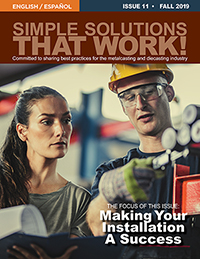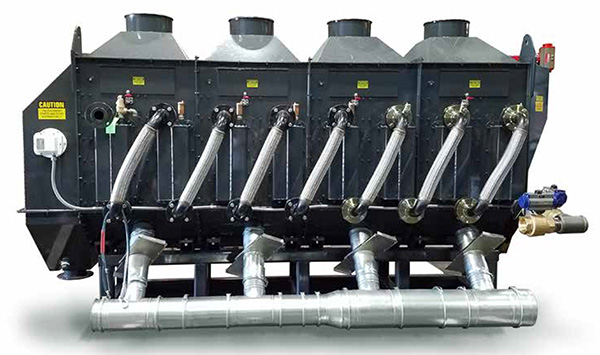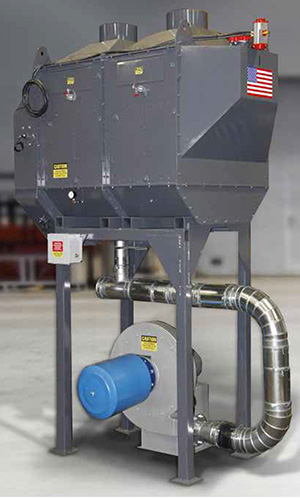Foundry & industrial processing Machinery EQUIPMENT & SYSTEMS
U.S. & Canada Call 1.800.457.5456
Home Articles

Simple Solutions That Work!™, Volume 11, September 2019
Written - Jack Palmer
Jack Palmer
President
Palmer Manufacturing & Supply, Inc.
Article Takeaways:
For foundries that prepare chemically bonded sand for molds and cores, optimizing the process means understanding and evaluating the primary features and options for water-based and electric-resistance systems.
In general, there are two types of sand heaters used to prepare chemically bonded sand for molding and coremaking, and both are designed as fluid bed processes — meaning the sand is moved around the heating/cooling elements with compressed air or blower air. The more popular style is the electric-resistance fluid bed with compressed air fluidization, followed by water-pipe units in which hot or cold water is passed through piping, with fluidized sand moving around them with blower air.
The popularity of the electricresistance type heater is due primarily to cost (compared with water-pipe designs) and size. The electric-resistance units are much smaller that the water pipebased designs, though both offer advantages.
The electric-resistance heaters are less expensive and smaller but are not as accurate as the water-pipe units, due to the relative retention time in each. The electricresistance heater can heat only; it cannot heat and cool like the water-pipe units. In higherkilowatt sizes, the water-pipe units might be a better long-term choice because the initial capital costs are comparatively higher than the electric-resistance type. Operating costs also are much lower, as the water is normally heated with a natural gas-fired heater and cooled with simple cooling tower water.
Higher-kilowatt (150-500 kW) electric-resistance heaters can have a significant effect on demand charges; they obviously use a high volume of energy. Over time, these demand charges would make the water-pipe design the better choice.
Electric-resistance type units are used in many industries for a variety of purposes, and commonly referred to as process heaters. They are used to heat granular materials with fluidization as well as liquids that are pumped through the unit. With normal maintenance and care, the electric-resistance style heater can be a very dependable and consistent piece of the no-bake molding process.

DESIGN DETAILS
These are a few of the critical fluidized-bed process components that need the operators’ attention:
- Fluidizing membrane.
Depending upon the sand grain size and temperature range, this membrane may be wire cloth or a simple canvas sandwiched between two support members. Both work equally well as long as they are specified for the purpose intended. It is important to keep the membrane in good condition. The most common problem for electric-resistance heaters is that the membrane becomes clogged with moisture, oil, particulate, or rust from the compressed-air piping. The normal solution to this is to install a simple, bowl-type compressed-air filter. While these filters collect most of the moisture and particulate, they are only about 80% efficient.
The Palmer design incorporates both a bowl filter and a 99% highefficiency, cartridge-type filtration unit right after it. This ensures all the air going into the pressure chamber and then through the fluidizing membrane is completely dry and completely clean. This will extend the service life of the membrane much beyond the effect of a bowl filter alone. - Pressure-chamber pressure gage.
The pressure gage in the pressure chamber under the fluidizing membrane usually is a 0-5-psi instrument; if the scale is higher it is impossible to be sure the pressure is set correctly. Normally, the pressure is increased "until the needle bounces," typically at 2-3 psi, depending on heater size and type of aggregate.
The bouncing needle means the sand is bubbling around within the housing, but not excessively. If the gage is fixed at 4 psi, or higher, it means that the compressed-air pressure is set so high that air is escaping as quickly as possible, which fluidizes the sand to the point that it is not contacting the elements as efficiently as it should be.
If the fluid bed becomes clogged, the common response to sand not exiting the heater is to turn up the fluidizing pressure. This will increase the sand flow, but it will over-fluidize the sand so that it will not have intimate contact with the heating elements, and there will be wide swings in temperature consistency. The first fix is to make sure the fluidizing membrane is in good condition. - Exhaust.
The exhaust from the fluid bed must be free-flowing at all times. Many times, this exhaust is connected right back to the top of the silo, into a bin vent, or tied into the plant dust-collection system. If there is a restriction in the piping this will affect the fluidizing pressure, which will affect the accuracy and consistency of the sand-discharge temperature and, in the case of extremely plugged exhaust, sand flow.
Normally, it is best to set up the exhaust line so that dust does not flow back into the silo. These fines and their variability can have a significantly detrimental effect on mold strength. Note, that all the exhaust piping should be vertical, or at least set at a 45° angle to avoid sand build-up in the vent lines. - Thermocouples.
Obviously thermocouples must be in good condition and properly wired because they are the means for controlling the rest of the machine functions. Palmer heaters are designed with a thermocouple junction in direct contact with the sand. It is important that the thermocouple junction is not in a cast iron or steel thermowell: A thermowell is simply a covering over the thermocouple to keep it from getting damaged or prematurely worn. While this works well to protect the thermocouple, it is highly detrimental to maintaining sandtemperature accuracy.
The temperature from the incoming sand may take minutes to go through the thermowell before it sees the thermocouple. By the time the controls react, the cold or hot sand already has exited the heater. On older units with thermowells, the readout will show very accurate temperature when in fact the sand exiting the heater may have temperature swings of 25° to even 50°F — and may not appear on the temperature readout.
If the thermocouple junction is directly in the sand, the increase or decrease in power applied to the elements is immediate, and is added only to increase the temperature as needed. This results in a much more accurate and repeatable discharge temperature.
Also, thermocouple wiring must be correctly "phased." The operating principle of a dissimilar metal thermocouple is that when the junction of the two metals (thermocouple wires in this case) is heated or cooled, a voltage is produced that can be measured, and correlated to a specific temperature. For this reason, it is important to be sure the correct wire runs from the temperature controller all the way to the terminals on the thermocouples without changing. When going through terminal blocks it is important that these wires do not go from one side of the terminal to the other. The mild steel of the terminal will have an effect on the reading. Thermocouples wires should be twisted together before putting in a terminal strip, or simply held together with a wire nut - Square, not round.
The Palmer design has a square body instead of a round body. While the pipestyle heater is less expensive to manufacture, it is substantially smaller in volume than a unit of the same kW capacity in a square design. This larger amount of sand in the heater results in a longer retention time in the heater. The longer the retention time, the more accurate will be the resulting discharge temperature.
PROCESS CONTROL ELEMENTS

SCR temperature controls, all together. Old-style heaters typically have control elements arranged in three or four different "banks." This is a holdover design from a time before SCR temperature controls were readily available and reasonably priced. This older style allows the first bank to get to as high as 1,000°F: If the first bank does not get the discharge sand to the set-point, a second bank comes on, etc. While this design was sufficiently effective for its time, there is a much better way to do this now.
The old-style heaters would use up many elements per season due to the thermal shock of going from 'red hot' to 'off' hundreds of times a day, as well as wearing out the contactors that connected and disconnected power to each bank.
Now, with affordable and precise SCR controls all elements can be installed in one bank, which results in only the needed volume of power being applied to the elements. As a result, the elements rarely exceed 250°F, which extends element life almost indefinitely, and also increases accuracy and repeatability for sand-discharge temperature. It is not uncommon for this style of heater to operate for years with zero maintenance costs.
Inlet butterfly valve, with timer and bypass. All Palmer electricresistance heaters are equipped with a summer bypass, which allows the sand simply to bypass the heating chamber under gravity. In the non-heating season the sand can flow directly from supply to the mixer. Normally this is a manual valve, however it also can be configured with a powered valve with proof of position.
There is another butterfly valve above the summer bypass that opens when heated sand is called for, when the mixer is shut down. This butterfly valve closes immediately but the fluidizing air stays on in the heater for an adjustable period of time, and keeps the sand in a homogeneous condition so that there are no temperature spikes if the mixer is cycled off and on.
If the elements are working hard to heat the sand to set-point they could be at a fairly high temperature. If the fluidization simply stops when the mixer is shut down, all of the residual heat in the elements goes directly to the surrounding sand, and the result will be that the temperature of the next sand coming out of the heater will be substantially higher than set-point for at least a few minutes, which can be highly detrimental to the molding process.
High-temp safety system. All heaters should be equipped with a high-temperature safety system so that if there is a component failure, the system shuts off and an alarm alerts the operator. The Palmer design is normally set at 150°F, so that if there is a problem the power to the heater will be cut off. This is rare, but it’s necessary to ensure a safe and reliable operation.
The water-pipe heater/coolers have a number of advantages over the electric-resistance type. While a water-pipe design is roughly two to three times higher in cost, the accuracy and lower power requirements easily can offset the higher price. When performing the suitability analysis for one design versus the other, all associated costs and operating efficiencies need to be included.
INSTALLATION
Installation of these 2 types of heaters is quite different mainly due to their respective size difference. The electric-resistance style can usually be simple mounted below the supply silo between the silo discharge and the piping to the mixer inlet or the next process be it a continuous mixer, batch mixer, transporter, or any other process. It is important to always consider temperature losses when installing either type mixer if the discharge isn’t going directly into the next process. Piping, interim hoppers, transport distance, etc., must all be taken into consideration when installing these heaters.
The traditional mount method is with threaded rods in each corner or the upper end of the heater although this may differ from manufacturer. It is usually a simple matter to run some structural steel in the support steel of the silo to hold these threaded rods – while these heaters are not small, the support structure for these heaters is usually more than sufficient to handle this comparatively small additional weight.
Since the fluidization of this design heater can sometimes be powerful, a bracket towards the bottom of the heater tying it to a beam close by will eliminate any lateral movement. In standard design, all sides of the heater plus the bottom need to be accessible so it is important any support structure keeps all sizes and the bottom of the heater open. When installing, it usually is a small amount of work to add in a catwalk to make servicing of these heaters simpler and safer – obviously these catwalks will need to meet all applicable requirements for safety of design: railings, ladder access, tie off points etc. The alternative is ladder work which should be avoided at all times
Water Pipe Based Heaters
Since the water pipe based heater design units are much larger, their size as well as substantially higher weight will need to be taken into account. Since the retention time of the water pipe based heaters is much longer than the electricresistance heater, the weight is substantially higher. The weight of the heater itself as well as the amount of sand in it are added together to calculate the necessary support.
With the inlet at the top on one end of the heater and the discharge at the bottom of the other, the elevation requirements are somewhat greater than the electric-resistance design. If the silo is connected directly to the inlet, the discharge will normally extend beyond the footprint of the silo support structure. In new installations, this is not difficult to design around – in replacement or installations in existing facilities, this can be problematic. Elevation is always at a premium in any installation like this, but there are a number of design techniques that can be used to account for a lack of elevation which will not be addressed in this article.
The support structure may be of sufficient strength to include the additional weight of the water pipe style heater, but this additional weight should be carefully calculated into the support structure to be sure it is sufficient and still have a reasonable safety factor. As with the electric-resistance type heater, it is important that this heater is supported in such a way that all service, inspection, and maintenance procedures can be performed quickly and safely. Normally the design of the water pipe design does not allow for support directly under the unit, but this will vary from manufacturer to manufacturer.
As with the electric-resistance design, a carefully designed catwalk will allow for safe and quick performance of all inspection, maintenance, and service work. With the older straight tube bundle designs, there must be sufficient space to allow the bundle to come out of the housing, and safely lowered to the ground before installing the replacement – while tube bundle replacements aren’t usually needed very often, the replacement can be a multi-day process if allowances aren’t made for safe and efficient replacement. The older linear tube designs are slowly being replaced by the modular designs. With the modular design, the cooling bundles are removable from the side which is quick and performed safely in a few hours in the rare case of a cooling bundle getting worn to the point where it leaks. It is a simple matter to disconnect the incoming and outgoing water pipes; remove the mount bolts and replace. If there isn’t time to replace them, it is also a simple matter to bypass a given module until there is sufficient time to replace the cooling bundle after hours or off shift. The modular design uses a series of adjustable weirs which force the sand into a tortuous path to get through the body of the heater/cooler – this allows for much more accurate temperature control than the older straight tube design
CAPITAL AND POWER REQUIREMENTS

Depending on flow rate, incoming sand temperature, and desired set-point, a water-pipe design unit will cost twice as much as an electric-resistance design, with the very real potential to be three to four times as expensive once the installation costs are included.
Depending on local utility standards, the demand charge simply for turning on an electric-resistance style heater for 30 minutes can be a large percentage of the monthly operating cost. If the foundry is not on a demand/time-of-day metering system this is not a problem, however most plants are on a demand-based system. Even a small, 300-lb/minute ER-style heater at 45 kW can be expensive to turn on and operate. If larger units for 1,000-3,000 lb./minute are used, running at 150-300 kW, the demand charges can be thousands of dollars even before the energy used is calculated.
Because sand fluidization in an electric-resistance style system is accomplished with plant compressed-air, the cost of compressed-air must be included in the operation calculations. Depending on power costs and capital expenses, compressedair can be reasonable to very expensive. A 300 lb./minute, 45- kW heater will use approximately 30-40 CFM at an incoming plant pressure of 90 psi. A 2,000-lb/ minute heater can use up to 150 CFM, depending on fluidization pressure.
In general, a reciprocal-style air compressor will generate about 4 CFM per HP, with a screw-type compressor generating about 3.5 CFM per HP. This means that a 2,000-lb/minute heater potentially may require the equivalent of 45 HP. This is not an insignificant amount; many times compressed air is thought of as a standard resource that simply comes with the building, and this obviously is not the case.
High-pressure, regenerativetype blowers can be used to fluidize the sand in electricresistance type heaters at a lower energy cost in comparison to compressed air, but these blowers have comparatively high HP requirements per CFM. Sometimes the regen blowers are a good choice but the air generated can be as high as 150-175°F.
While this is not a problem when heating, it can be problematic when only a small amount of heat is required, or if no heat is required at all and the fluidization is being used only to move the sand through the heater. Comparably sized, water-pipe-style heaters will require much less connected power. Fluidization pressure normally is supplied with a blower at about 5 HP for a small, 300-lb/ minute unit up to approximately 25-40 HP for a 2,000-lb/minute unit.
Normally, heating is supplied by a gas-fired boiler, which requires very little power to run the water pump. Natural gas is known to be a very inexpensive heat source. The energy required to run a water-pipe system will need to be calculated for each application in a particular region, but easily can be as low as 10% of the cost of an electric-resistance type. Cooling normally is achieved with cooling water from a simple cooling tower, enclosed or not, but this cooled water also is very inexpensive once capital costs are covered. Many times, larger plants will have cooling water readily available plant-wide.
HEATING AND COOLING
Because the water-pipe style offers the added advantage of cooling sand that is too hot or heating sand that is too cold, greater efficiencies and higher production can be achieved in the mold- or coremaking processes. While difficult to quantify, molds and cores will be of higher quality and require lower binder additions if the sand temperature is consistent and repeatable at the mixer. The change from heating to cooling normally is seasonal, but depending on the size of the supply-silo and the source of the incoming sand, it may require both heating and cooling on the same day.
For instance, if cold new sand is transported to the silo feeding the heater/cooler, it will be necessary to heat the sand to the desired set-point. If sand from shakeout or reclamation comes in behind the cold sand, cooling will be necessary. Obviously the goal is to control the variable incoming temperature as much as possible, but the water-pipe style heater can accommodate large swings in incoming sand temperature.
Heater size. The main disadvantage of a water-pipe design over the electric-resistance units is size. In order to achieve the heating or cooling ranges associated with an efficient modern foundry, retention time must be long enough so that the sand can absorb or release the volume of BTUs needed to achieve set-point.
If the application is for a new installation, this larger size can be accommodated easily. For existing installations, many times there simply is not enough elevation or lateral space to locate a water-pipe style unit. A correspondingly sized, waterpipe unit is larger than an electricresistance unit, not only in elevation but in length.
Sometimes it is an advantage to be able to convey sand from supply over to a mixer, but not always (depending on the location and installation.) Height, or headspace, also is needed for the exhaust piping because fullsize sand grains can float into the dust-collection piping.
Good design calls for a properly sized vertical duct to run vertically for at least 4 ft., so that full-sized sand grains can drop out of the dustladen air. The sizing of the vertical duct as well as the size of the lateral duct must be carefully engineered to ensure the minimal volume of sand goes to dust collection, and that sand does not accumulate in lateral ducting.
If height restrictions do not allow for this vertical duct, the lateral duct size must be calculated to keep the dust in suspension so that it moves easily to the dust collector. A standard drop-out box normally will need to be located close to the heater to ensure sand does not build up in lateral ducts, or go to the dust collector.
Fines control. Anytime sand is moved, fines are generated. Because the water-pipe design requires a larger volume and correspondingly longer retention time, the fines generated can be very closely controlled, in comparison to the electricresistance style. For example, a 500-lb./minute electric-resistance heater has a sand volume of approximately 800 lb., in general. This results in a maximum retention time of less than 2 minutes.
A correspondingly sized, waterpipe design will hold as much as 10,000 lb., resulting in a retention time of as much as 20 minutes. Not only will this greatly increase the accuracy potential but any fines that are generated in transport and sand flow can be controlled very well by balancing the fluidization pressure and dust collection.
Obviously, for many applications a certain amount of fines is desired, but the water-pipe-style heater has the ability to control this amount very accurately and consistently. It is important that dust collection is set correctly and remains the same through the course of the day. Often, if a water-pipe heater is connected to the plant-wide dust-collection system, there can be huge swings in the volume of dust collected, which will result in less accurate fines control.
As always with process equipment there are advantages and disadvantages to all designs. By carefully addressing the above considerations, selecting the correct sand heater-cooler design can be made easier and, hopefully, more quantifiable.
This is a longer version of an article originally published in Foundry Management & Technology.
Republished with permission from Informa USA.
www.foundrymag.com
Copyright © 2025 Palmer Manufacturing & Supply, Inc. | Terms and Conditions | Privacy Policy




